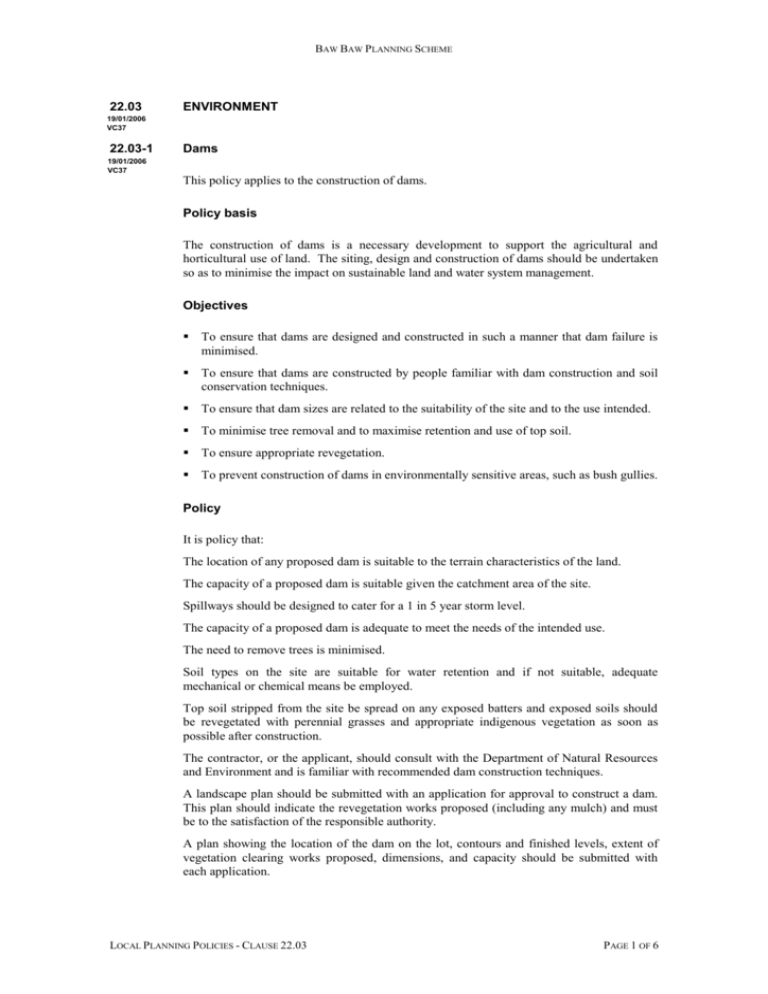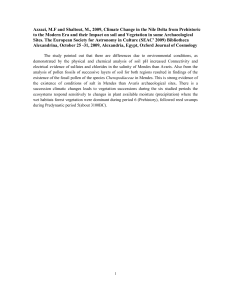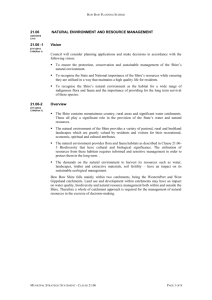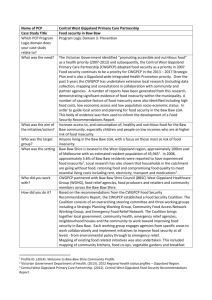schedule to the mixed use zone - Department of Transport, Planning
advertisement

BAW BAW PLANNING SCHEME 22.03 ENVIRONMENT 19/01/2006 VC37 22.03-1 Dams 19/01/2006 VC37 This policy applies to the construction of dams. Policy basis The construction of dams is a necessary development to support the agricultural and horticultural use of land. The siting, design and construction of dams should be undertaken so as to minimise the impact on sustainable land and water system management. Objectives To ensure that dams are designed and constructed in such a manner that dam failure is minimised. To ensure that dams are constructed by people familiar with dam construction and soil conservation techniques. To ensure that dam sizes are related to the suitability of the site and to the use intended. To minimise tree removal and to maximise retention and use of top soil. To ensure appropriate revegetation. To prevent construction of dams in environmentally sensitive areas, such as bush gullies. Policy It is policy that: The location of any proposed dam is suitable to the terrain characteristics of the land. The capacity of a proposed dam is suitable given the catchment area of the site. Spillways should be designed to cater for a 1 in 5 year storm level. The capacity of a proposed dam is adequate to meet the needs of the intended use. The need to remove trees is minimised. Soil types on the site are suitable for water retention and if not suitable, adequate mechanical or chemical means be employed. Top soil stripped from the site be spread on any exposed batters and exposed soils should be revegetated with perennial grasses and appropriate indigenous vegetation as soon as possible after construction. The contractor, or the applicant, should consult with the Department of Natural Resources and Environment and is familiar with recommended dam construction techniques. A landscape plan should be submitted with an application for approval to construct a dam. This plan should indicate the revegetation works proposed (including any mulch) and must be to the satisfaction of the responsible authority. A plan showing the location of the dam on the lot, contours and finished levels, extent of vegetation clearing works proposed, dimensions, and capacity should be submitted with each application. LOCAL PLANNING POLICIES - CLAUSE 22.03 PAGE 1 OF 6 BAW BAW PLANNING SCHEME For an application for a permit to construct a dam, the responsible authority will seek the comments of the Department of Natural Resources and Environment and any relevant Drainage or Water Authority. The responsible authority will consider the comments received from such authorities prior to deciding an application. 22.03-2 Soil removal 19/01/2006 VC37 This policy applies to the removal of soil from any site. Policy basis The Shire’s soil resources, particularly highly productive soils identified in the Assessment of Agricultural Quality in Gippsland (Swan and Volum, 1984), are a major natural resource which should be protected and managed. Objectives To ensure that productive soils are not lost from agricultural and horticultural production. To ensure that the future of agricultural industries are not prejudiced by the removal of soils. To ensure that the natural environment is not degraded by loss of soil, degradation of water quality or loss of native vegetation and habitat. Policy It is policy that: Soil should only be removed from the actual site of a building or works permitted pursuant to this planning scheme and where it can be demonstrated that the retention of the soil would prejudice the proper construction of the building or work. For an application for a permit for the removal of soil, the responsible authority will seek the comments of the Department of Natural Resources and Environment and any relevant Drainage or Water Authority. The responsible authority will consider the comments received from such authorities prior to deciding an application. 22.03-3 Use and development of land for conservation purposes 15/03/2006 C35 This policy applies to the use or development of land in the Farming Zone which has not been cleared of native vegetation. Policy basis Land which, because of its natural characteristics, has not been cleared and used for agriculture is an important resource which needs to be conserved and managed. In many cases the use of such land for agriculture purposes would be detrimental to the environment and conservation values of the site and surrounding area. Land which is managed for conservation purposes should require regular monitoring and control of pest plants and animals. LOCAL PLANNING POLICIES - CLAUSE 22.03 PAGE 2 OF 6 BAW BAW PLANNING SCHEME Objectives To use and manage land that has substantial natural attributes for the conservation of vegetation, habitat, flora and fauna. To ensure that the conservation values of the site are enhanced and that environmental management plans are implemented. To ensure that design, siting and location of all development does not affect water quality or habitat. Policy It is policy that: All applications for use or development should be accompanied by an environmental management plan containing: An environmental assessment of the site. An assessment of the vermin, weed infestation, and environment of the site and proposed control measures to remove these characteristics from the site. Future improvement measures for: Reafforestation. Watercourses. Flora and fauna. Habitat. Staging of the management plan and the proposed cost of implementation. Proposed conservation covenants, agreements and bonds with the responsible authority for the completion of specified works within an agreed environment management plan. Decision guidelines It is policy that: The responsible authority in assessing applications should consider the following: Environment Whether the use or development will be detrimental to the natural physical features or resources of the area. The protection and enhancement of the natural environment and character of the area including the retention of flora and fauna habitat and the need to plant indigenous vegetation along waterways, gullies, ridgelines and property boundaries. The impact on the character and appearance of any area or feature of architectural, historic, or scientific significance, or of natural beauty, interest, or importance. The impact on plant life, animal habitats and the landscape. The impact of the use on water quality. Measures to cope with any environmental hazard or constraint including slope, drainage, salinity, and erosion. LOCAL PLANNING POLICIES - CLAUSE 22.03 PAGE 3 OF 6 BAW BAW PLANNING SCHEME Measures to cope with fire. Site constraints Land capability and site attributes such as habitat, flora and fauna, native vegetation, fire, and soil erosion hazards. Proximity to watercourses and drainage lines. Location within salinity discharge / recharge areas. Infrastructure The treatment and retention of all waste water emanating from development (in accordance with the State Environment Protection Policy (Waters of Victoria) under the Environment Protection Act 1970.) located on the site and its affect on the conservation values of the site. Potable/non potable water supply and appropriate storage capacity. Reticulated electricity supply or alternative energy supply to the satisfaction of the responsible authority. Access to roads and compliance with the Baw Baw Shire Road Construction Policy. Land use on adjoining public land The relationship of the use or development to the existing or likely use of adjoining or public land. Design and siting issues The design and siting of any buildings and works. The location of any buildings and works with respect to the natural environment, major roads, vistas and measures designed to reduce the impact of buildings and works. The location and design of existing and proposed roads and their impact on the conservation values of the site. Whether the site has suitable access and what measures are required to upgrade access. 22.03-4 Steep land 19/01/2006 VC37 This policy applies to land in the rural zones with a slope greater than 20%. Policy basis Large areas of the Shire’s rural land is on steep and often cleared land. Much of this land is unsuitable for further development or should only be developed in accordance with strict conditions in relation to the site and characteristics and environmental conditions. Objectives To ensure that development on land with greater than 20% slope takes into account environmental constraints such as erosion and fire hazard. LOCAL PLANNING POLICIES - CLAUSE 22.03 PAGE 4 OF 6 BAW BAW PLANNING SCHEME That appropriate landscaping of sites and the design of buildings and works be undertaken to ensure that landscape values, natural features and important vistas are not lost or degraded. Policy It is policy that: The design and location of buildings and works should not be prejudicial to the site and its attributes. Earthworks are minimised and any necessary earth works are undertaken in accordance with advice from the Department Natural Resources and Environment. Removal of native vegetation is minimised. Development avoids prominent ridge lines. The location and design of access roads or driveways causes minimal visual impact. Landscaping and tree planting should be undertaken to screen buildings where appropriate. Buildings should not be erected on any land which is subject to subsidence or landslip. 22.03-5 Removal of native vegetation 19/01/2006 VC37 This policy applies to proposals for the removal of native vegetation. Policy basis Native vegetation is a significant natural and landscape resource throughout the Shire. The retention of native vegetation, including individual large trees, is supported. The removal of native vegetation, including large trees, is to be undertaken only after consideration is given to relevant factors. Objectives To preserve native vegetation, including large trees and significant avenues of trees. To protect significant and sensitive areas from the adverse impacts of vegetation removal. To protect fauna and flora. To provide for the removal of native vegetation where it is demonstrated that it is necessary as part of an approved use of land. Policy It is policy that: The landscape characteristics of the locality are considered. Plans accompanying an application adequately identify the area of native vegetation to be cleared and consideration is given to specifying requirements for replanting and protecting native vegetation. There is a demonstrated need for the removal of native vegetation associated with an approved development. LOCAL PLANNING POLICIES - CLAUSE 22.03 PAGE 5 OF 6 BAW BAW PLANNING SCHEME The removal of native vegetation should not jeopardise the integrity and long term conservation of any site of botanical and zoological significance. Consideration will be given to: The value of the native vegetation in terms of its physical condition, rarity or variety. The likely effect of the removal of native vegetation on the fauna of the area and its value as a refuge or habitat for wildlife. The future use of the land and whether it is appropriate to include conditions requiring planting, replanting or other treatment of any part of the land. The existing and future amenity of adjoining land and of the native environment of the neighbourhood. The removal of native vegetation is not preferred on land which: Is within 30 metres of a watercourse. Has a slope in excess of 20 per cent. Policy reference Sites of Biological Significance - Baw Baw Shire, Department of Natural Resources and Environment, Version No. 2 - 17 July 1997. LOCAL PLANNING POLICIES - CLAUSE 22.03 PAGE 6 OF 6









